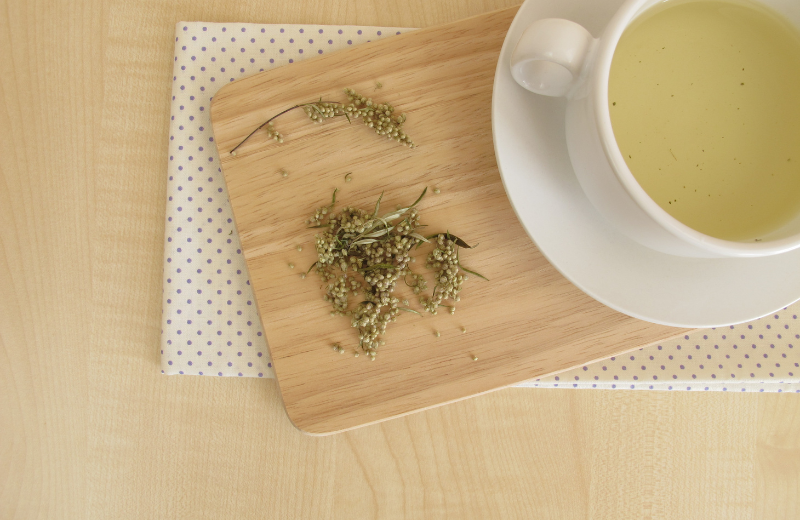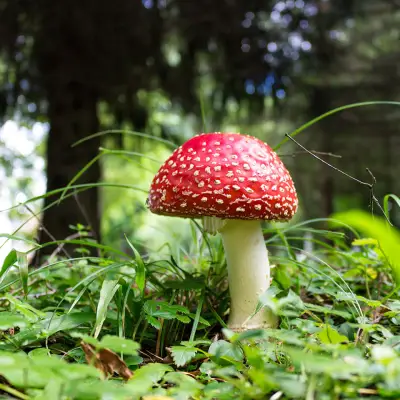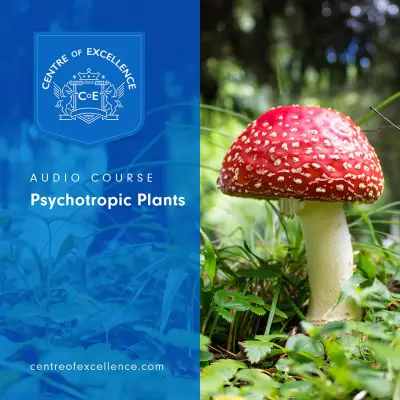Mugwort is a herbal remedy that’s often used in traditional medicine, spiritual practices, and even cooking. But what exactly is mugwort, and why is it so highly regarded? This article explores its uses, benefits, and potential side effects.
This article is for informational purposes only and is not a substitute for professional medical advice, diagnosis, or treatment. Always consult with your GP or a qualified healthcare professional before starting any new herbal remedies, especially if you are pregnant, breastfeeding, taking medication, or managing a health condition.
Jump to:
- What is Mugwort?
- The Benefits of Mugwort
- What Types of Mugwort Can You Take?
- What is the Best Form of Mugwort to Take?
- How Much Mugwort Should You Take, and When?
- What Are the Side Effects of Mugwort?
- Who Should Avoid Mugwort?
- Is Mugwort Safe for Long-Term Use?
- Other Common Questions About Mugwort
- Study Our Master Herbalist Diploma for £29
Recommended for you!
Best SellersWhat is Mugwort?
Mugwort, also known as Artemisia vulgaris, is a perennial herb native to Europe, Asia, and North America. It’s characterised by its distinct aromatic scent, deeply lobed green leaves, and reddish stems.
Traditionally, mugwort has been used to support digestion, menstrual health, and sleep. It contains essential oils, flavonoids, and other compounds believed to offer various health benefits. It’s also associated with spiritual practices and is often burned as incense or used in rituals.
The Benefits of Mugwort

From digestive support to skincare, mugwort offers a range of applications that have intrigued herbalists and wellness enthusiasts:
Digestive Health
Mugwort is commonly used to aid digestion. It’s believed to stimulate digestive enzymes, reduce bloating, and reduce mild gastrointestinal discomfort. Consuming mugwort tea after meals may help soothe the stomach and promote digestion. Additionally, it’s said to support liver function by promoting the flow of bile, which is essential for breaking down fats and easing digestion. Some herbalists also use mugwort as a remedy for indigestion and mild constipation.
Menstrual Support
Mugwort is sometimes used to support menstrual health. It’s thought to regulate menstrual cycles and reduce cramps. Some people drink mugwort tea or use tinctures to bring on delayed periods. This herb is also considered a mild emmenagogue, meaning it may help to stimulate blood flow in the pelvic area and uterus. However, it’s essential to consult a healthcare provider before using mugwort for menstrual issues, especially for those with underlying health conditions.
Sleep and Dreams
Mugwort has gained popularity as a natural sleep aid. It is said to induce vivid dreams and enhance dream recall. Drinking mugwort tea before bed or placing dried mugwort under the pillow are common practices. The herb is believed to contain compounds that affect the nervous system, promoting relaxation and potentially easing stress before sleep. For those interested in dreamwork or lucid dreaming, mugwort is often recommended as a potent ally.
Skin Health
Mugwort is also found in skincare products, particularly in East Asian formulations. It’s believed to soothe irritation, reduce redness, and promote a clearer complexion. The herb is rich in antioxidants that help protect the skin from environmental damage and free radicals. Mugwort-infused creams and oils are also said to be beneficial for managing acne, eczema, and other inflammatory skin conditions, making it a popular choice in holistic skincare routines.
Respiratory Health
Some people smoke mugwort or burn it as incense to clear the lungs and support respiratory health. However, caution is advised, as inhaling smoke can be harmful. Mugwort is also said to have mild expectorant properties, potentially helping to loosen mucus and reduce congestion. Additionally, the aromatic compounds in the herb may have calming effects on the respiratory system, making it a popular choice in herbal smoking blends.
What Types of Mugwort Can You Take?
Mugwort is available in various forms, allowing you to choose based on your wellness goals, preferences, and lifestyle. Each form offers unique benefits, making it easier to incorporate mugwort into your daily routine.
You can choose from teas, capsules, tinctures, dried leaves, essential oils, creams, and smoking blends. Some formats are ideal for sleep and relaxation, while others are more suitable for topical applications or spiritual practices.
What is the Best Form of Mugwort to Take?

- Mugwort Tea: Mugwort tea is one of the most popular and traditional ways to consume mugwort. It’s often used to support digestion, induce relaxation, and promote vivid dreaming. This form is ideal for those who want a calming ritual before bed or those exploring dreamwork. Simply steep dried mugwort leaves in hot water for 10-15 minutes and enjoy as a warm, soothing drink.
- Capsules: Capsules provide a convenient and controlled way to take mugwort. They’re easy to travel with, require no preparation, and ensure consistent dosing. Capsules are perfect for those who want to integrate mugwort into their routine without the taste or aroma, making them a practical option for daily use.
- Tinctures: Herbal tinctures are concentrated liquid extracts that are typically alcohol-based. They can be taken under the tongue or diluted in water for rapid absorption. This form is ideal for those looking for a potent, fast-acting option. Tinctures are especially popular for menstrual support or digestive relief, as the concentrated formula allows for targeted dosing.
- Dried Leaves: Dried mugwort leaves can be used in several ways, including making tea, smoking, or burning as incense. This form is versatile and is often used for spiritual practices or dream enhancement. Dried mugwort can be placed under a pillow to encourage vivid dreams or burned to cleanse a space and promote relaxation.
- Essential Oil: Mugwort essential oil is a concentrated extract often used topically. It’s typically diluted and applied to the skin to soothe irritation, reduce inflammation, and support menstrual relief. This form is ideal for those focusing on skin health or massage therapy.
- Creams and Ointments: Mugwort-infused creams and ointments are designed for topical use. They are often used to calm irritated skin, reduce redness, and promote a clearer complexion. This form is particularly popular in Korean skincare products, where mugwort is known for its soothing properties.
- Smoking Blends: Some people smoke dried mugwort leaves to experience its calming and dream-inducing effects. Mugwort is often combined with other herbs to create herbal smoking blends. However, caution is advised, as smoking any herb can irritate the lungs. This form is primarily used for ritualistic or spiritual purposes.
How Much Mugwort Should You Take, and When?
The appropriate dosage of mugwort varies depending on the specific form and intended use. Typical dosages include:
- Tea: 1-2 teaspoons of dried mugwort steeped in hot water for 10-15 minutes. This can be consumed 1-2 times daily, especially in the evening for dreamwork or relaxation.
- Capsules: Follow the product’s instructions, usually 300mg to 600mg per day, taken with water.
- Tincture: Start with a few drops diluted in water, up to three times a day. Adjust the dosage based on the desired effects.
- Dried Leaves: If smoking or burning, use a small amount to avoid inhaling excessive smoke.
- Essential Oil: Apply a few drops to the skin, diluted in a carrier oil. Avoid direct application without dilution.
- Creams and Ointments: Apply a small amount to the affected area 1-2 times daily.
- Smoking Blends: Start with a small amount to assess tolerance, as inhaling herbs can be harsh on the lungs.
It’s recommended to start with a lower dose, especially if you are new to mugwort, and gradually increase as needed. For dream enhancement, mugwort is typically used before bed, while for digestive support, it may be taken after meals.
For consistent support, daily use during times of stress, menstrual discomfort, or sleep disturbances can be beneficial. When using mugwort for short-term purposes, such as dreamwork or spiritual rituals, limit use to a few days at a time to prevent potential side effects.
What Are the Side Effects of Mugwort?

Common side effects of mugwort are generally mild and occur mainly when the herb is consumed in large quantities or used for extended periods. While most people tolerate mugwort well, some may experience:
- Digestive discomfort, such as nausea, gas, or stomach cramps
- Drowsiness or mild sedation, especially when taken in larger doses
- Allergic reactions, including skin rashes or itching
- Headaches or dizziness in some cases
Mugwort contains compounds that can potentially be toxic when consumed in excessive amounts or over prolonged periods. The herb also contains thujone, a compound that can be neurotoxic if ingested in large doses. This is particularly a concern when using concentrated essential oils or tinctures. Those with allergies to plants in the Asteraceae family, such as ragweed, may also be at higher risk of an allergic reaction.
Who Should Avoid Mugwort?
Pregnant and breastfeeding women should avoid using mugwort, as it may stimulate the uterus and increase the risk of miscarriage. People with liver conditions or those taking medications that affect liver function should also exercise caution, as mugwort may contain compounds that could strain the liver.
Those with a history of seizures or epilepsy should avoid consuming large doses of mugwort, as thujone can potentially trigger seizures. People with known allergies to ragweed, daisies, marigolds, or chrysanthemums should also steer clear of mugwort, as cross-reactivity may occur.
Is Mugwort Safe for Long-Term Use?
Short-term use of mugwort is generally considered safe for most healthy adults when taken in moderate amounts. However, the long-term effects of daily supplementation or regular use have not been well studied. To reduce the risk of side effects and ensure the herb’s continued effectiveness, it’s often recommended to use mugwort in cycles.
Recommended for you!
Best SellersOther Common Questions About Mugwort
Can You Smoke Mugwort in the UK?
Smoking mugwort is legal in the UK, though it is important to be mindful of potential respiratory risks. While some people use mugwort in herbal smoking blends to promote relaxation or induce vivid dreams, excessive inhalation can irritate the lungs and airways.
Is Mugwort Poisonous to Dogs?
Mugwort can be toxic to dogs if ingested. Symptoms of mugwort poisoning in pets may include vomiting, diarrhoea, and lethargy, so it’s crucial to keep mugwort products out of reach of animals.
Why is Mugwort Called Sailor's Tobacco?
Sailors once used mugwort as a substitute for tobacco when supplies were low. The herb was often dried and smoked to help ward off fatigue, making it a convenient alternative for those at sea without access to traditional tobacco products.
What Part of Mugwort is Edible?
The leaves of the mugwort plant are the most commonly used and can be dried and brewed as tea. While the leaves can also be used in cooking or as a seasoning, the roots and stems are generally not consumed due to their bitterness and potential toxicity.
Does Mugwort Make Your Period Come?
Mugwort is considered a mild emmenagogue, meaning it may help stimulate blood flow to the pelvic area and uterus. As a result, some women use mugwort tea to bring on a delayed period or to reduce menstrual cramps, though caution is advised for pregnant women due to its potential uterine-stimulating effects.
What Does Mugwort Do for the Skin?
Mugwort is often included in skincare products for its soothing and anti-inflammatory properties. It may help reduce redness, calm irritated skin, and improve overall skin texture, making it a popular ingredient in Korean skincare formulations.
Can Mugwort Help with ADHD?
While mugwort is not a recognised treatment for ADHD, some people use it to promote relaxation and reduce anxiety, which may be beneficial for those with ADHD symptoms. However, there’s limited scientific evidence to support its effectiveness for this purpose, and consulting with a healthcare provider is recommended.
What Does Mugwort Do Spiritually?
Mugwort has a long history of use in spiritual and ritual practices. It’s believed to enhance intuition, stimulate lucid dreaming, and provide protection from negative energies. In some cultures, burning mugwort as incense is said to cleanse a space and promote clarity of thought.
Study Our Master Herbalist Diploma for £29
If you’ve found yourself fascinated by the potential of mugwort and other natural remedies, why not deepen your understanding? Whether you're a beginner or looking to expand your knowledge, Centre of Excellence offers a comprehensive Master Herbalist Diploma Course, designed for people of all levels.
The course covers everything from herb identification and preparation to building herbal blends for specific emotional and physical needs. Follow the link to access the course for just £29!













